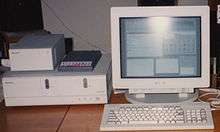Sony NEWS
The Sony NEWS ("Network Engineering Workstation", later "NetWorkStation") is a series of Unix workstations sold during the late 1980s and 1990s. The first NEWS machine was the NWS-800, which originally appeared in Japan in January 1987 and was conceived as a desktop replacement for the VAX series of minicomputers.[1][2]
History
1980s
Sony's NEWS project leader, Toshitada Doi, originally wanted to develop a computer for business applications, but his engineers wanted to develop a replacement for minicomputers running Unix that they preferred to use:[3]
In the beginning, Doi's concept of the workstation was a device, which was essentially an extension of current MIPS projects. He saw it as consisting of "a 32-bit CPU developed in a short time with unrestricted applications." Basically, he thought of it as an OA computer. However, the engineers Doi selected for his team did not listen to what Doi told them to do. They wanted to develop a workstation that could replace the VAX Super Mini Computer developed by Digital Equipment Corp. (DEC). This was a computer that the engineers often fought with each other to use while at MIPS because of the limited number. They wanted to develop something they themselves could use for their own day to day work.
Initial development of the NEWS was completed in 1986 after only one year of development. It launched at a lower price than competitors (¥950,000 to ¥2.75 million), and it outperformed conventional minicomputers.[3] After a successful launch, the line expanded and the new focus for the NEWS became desktop publishing and CAD/CAM.[3]
1990s
The Sony NEWS was unable to break into the U.S. market, where Sun Microsystems was dominant, and also did not fare well in Europe.[3]
The NEWS platform was later used for video-on-demand applications, and for Internet server applications.
The NEWS division at Sony was dissolved in 1998.
Hardware
The Sony NEWS originally came equipped with a dual 680x0 (68020 or 68030) processor configuration running at 16-25 MHz. Later, the Sony NEWS was moved to the MIPS architecture, with MIPS III and MIPS IV microprocessors such as the R3000, R4000, R4400, R4600, R4700, and R10000. The fastest MIPS processors used in Sony NEWS workstations ran at 200 MHz.[4]
Both 680x0 and MIPS models shared the same case, which had a large door covering a floppy drive and a 5.25-in expansion bay which could house a SCSI tape or CD-ROM drive. The details of the door were slightly different: two windows for the 680x0 models while the MIPS ones had a single large window. Also hidden by the cover were a reset button and a series of DIP switches used to configure some bootup parameters.
On the back were 3 expansion slots, one of which normally housed a video card. Underneath those were the connectors for SCSI, network (an AUI connector), serial (CH0, normally used for console, and CH1), parallel, and a keyboard.
Software
NEWS-OS
Originally the Sony NEWS team had to decide which version of Unix to use: BSD or AT&T System V. The project leader was interested in the potential commercial support for System V, but the engineering team preferred BSD because it had rich networking features including TCP/IP. Eventually BSD was chosen because they believed that computer networks would be important in the future.[5]
NEWS-OS releases were based on three different versions of Unix:[6]
- NEWS-OS 1.x: 4.2BSD, Shift JIS, introduced in 1987.
- NEWS-OS 2.x: 4.2BSD, Shift JIS, introduced in 1987.
- NEWS-OS 3.x: 4.3BSD, EUC, introduced in 1988.
- NEWS-OS 4.x: 4.3BSD, EUC, introduced in 1990.
- NEWS-OS 5.x: SVR4.2, EUC, introduced in 1992.
- NEWS-OS 6.x: SVR4.2, EUC, introduced in 1993.
Prior to version NEWS-OS 3.9, all versions of NEWS-OS were released exclusively for the 680x0 series of processors. NEWS-OS 3.9 was released in both CISC ("C") versions and RISC ("R") versions, for the 680x0 and the MIPS architecture, respectively. For example, NEWS-OS 3.9 was released as both "NEWS-OS 3.9C" and "NEWS-OS 3.9R." Functionality was the same between the CISC and RISC versions. The NEWS-OS 4.x series was also released in both CISC and RISC versions.[6]
Third-party software
Yukihiro Matsumoto originally began implementing the Ruby programming language on the 4.3BSD-based NEWS-OS 3.x, but later migrated his work to SunOS 4.x, and finally to Linux.[7][8] In 1999, Ruby was known to work across many different operating systems, including NEWS-OS.[9]
See also
References
- ↑ SONY History 第12章 苦闘する新分野への進出 第2話 社内ベンチャーから生まれた「NEWS」 - Sony official Web site (Japanese)
- ↑ IPSJ Computer Museum - Historical Computers in Japan, Workstations - Sony NWS-800 Series (Prototype)
- 1 2 3 4 "Sony History: NEWS – An Independent Venture". Retrieved 3 February 2013.
- ↑ Katsu Watanabe. "SONY NEWS Series hardware specifications". Retrieved 2015-12-10.
- ↑ "NEWS --- 一人1台を実現したワークステーション". 20 September 2006. Retrieved 4 February 2014.
- 1 2 "Sony NEWS-OS Releases".
- ↑ Maya Stodte (February 2000). "IBM developerWorks – Ruby: a new language". Archived from the original on August 18, 2000. Retrieved 3 March 2014.
- ↑ Yukihiro Matsumoto (August 2002). "lang-ruby-general: Re: question about Ruby initial development". Retrieved 3 March 2014.
- ↑ Yukihiro Matsumoto (5 January 1999). "ruby-talk: Re: hah, check these errors". Retrieved 3 March 2014.
External links
| Wikimedia Commons has media related to Sony NEWS. |
- Sony History: NEWS – An Independent Venture
- SONY NEWS Series hardware specifications
- Xi FTP service software repository for NEWS-OS 6.1
- webpage about SONY NEWS 1580 webpage about Sony NEWS 1580
- FAQ on running netbsd on a SONY NEWS 68030-based (news68k) workstation. A version for the RISC version is also available.
- History for the Sony NEWS workstations
